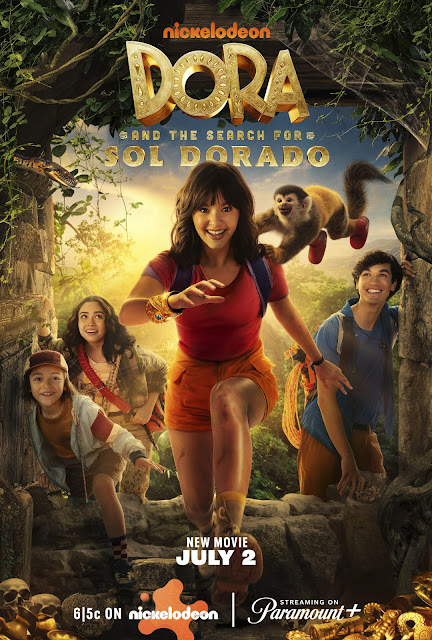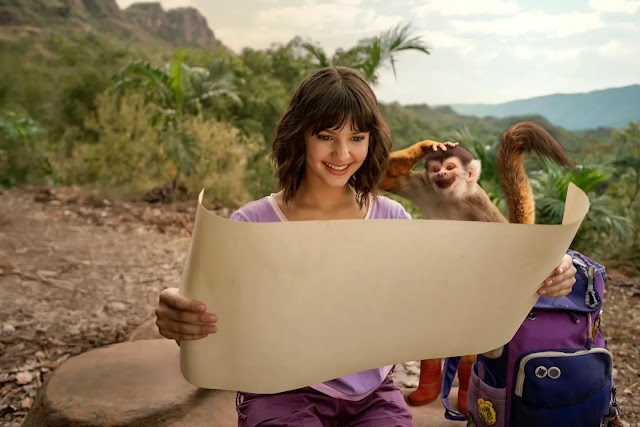Twenty-five years ago, a little girl with a bob haircut appeared on our TVs, speaking a mix of English and Spanish, with a spunky, can-do spirit. She had an adventure planned, a backpack, a monkey friend and upbeat songs.
“Hi, I’m Dora. What’s your name?” she asked.
This was, of course,
Dora the Explorer, the first Latina to lead a major animated series and the girl who helped spearhead the rise of multicultural children’s programming in the U.S. on her way to becoming a cultural phenomenon.
“The show allowed Latinos to be depicted on TV as educators, teaching viewers how to speak our language, and yet at the same time, just teaching ordinary things that children need to learn,” Brenda Victoria Castillo, president and CEO of the
National Hispanic Media Coalition, told the
Associated Press.
Nickelodeon is celebrating Dora’s 25th anniversary with the “
The Great Dora Fiesta,” which includes the feature-length live-action movie
Dora and the Search of Sol Dorado, a third season of the rebooted animated series
Dora, the podcast
Dora’s Mermaid Adventures, an album of songs and plenty of toys and apparel.
“The great thing about Dora is that, yes, she celebrates Latin culture through every aspect — language, food, dress and music,” says Ramsey Naito, president of animation at Paramount and Nickelodeon. “But she also empowers everybody to be their true self and to be brave. She’s not exclusive. She’s inclusive.”
The original voice
Kathleen Herles had a special vantage point to see Dora’s influence: She was the original voice of the pint-size heroine, cast in the role when she was 7 and staying until she was 18 and off to college.
“It has been the longest journey and the greatest adventure of my life — no pun intended,” said Herles, who grew up in New York City to parents of Peruvian descent.
On the convention circuit, Herles would see firsthand the power of Dora. “I remember I would make kids cry, not intentionally,” she says. “Their mind goes to a memory, to a moment, it’s just incredible. It’s so special, it’s magical.”
Herles has lately been the voice actor for Dora’s mom on Dora, the CG-animated reboot that started in 2024. It’s a full-circle moment for the actor and singer: “It changed my life forever, twice.”
Dora co-creator Chris Gifford has watched his creation age up and down and take human form. “She has been older and she has been younger and she has a hair clip now,” he says. “Her essence, her positive spirit, her I-can-do-anything-with-your-help attitude has stuck through.”
Dora is firmly part of the culture, as big as her
Macy’s Thanksgiving Day Parade balloon. There’s a reference to her in
Inside Out 2, she’s been mocked on
Saturday Night Live and if you look carefully at the PBS show
Alma’s Way, you can see a Dora doll in that heroine’s bedroom. TikTok users have embraced the “Backpack Song.”
“Those kids coming of age now — the ones who 25 years ago were just watching it as little preschoolers — they’re out there and they’re remembering,” says Valerie Walsh Valdes, co-creator of the original series and an executive producer on the new series and movie.
Creating a problem solver
Valdes and Gifford originally had the idea for a show about a little girl who was a problem solver. Like
Blue’s Clues, it would reward kids for figuring out answers posed by the host.
“Preschoolers are the least powerful people in our world,” says Gifford. “They’re not able to button their sweater and not able to tie their shoes, but if they’re able to help Dora get to the City of Lost Toys and really feel like they helped, that’s something special.”
Nickelodeon suggested the girl be Latina and the creators ran with it, making her pan-Latina so no one would feel excluded. Latin representation on TV — then and now — has been a struggle.
The Latino Donor Collaborative’s
2024 Latinos in Media report found that Latino actors made up 9.8% of the main cast in lead, co-lead and ensemble roles in scripted shows. In non-scripted television, Latino hosts made up only 5% of host roles. That’s despite Latin people making up nearly 20% of the country.
“There were few programs at the time that featured Latina protagonists with Dora’s skin tone or features, so from that perspective, the representation is valuable,” says Erynn Masi de Casanova, head of the sociology department at the University of Cincinnati.
Dora was put in an animated world inside a computer, and the creators asked kids to help make the show better. They hired education consultants to tease out the skills Dora teaches, like spatial understanding and interpersonal. They brought in language and culture experts.
“We did it!” became her signature song.
Bilingual heroine
The series is seen in more than 150 countries and territories and translated in 32 languages on Nickelodeon channels and Paramount+. In English-speaking countries such as the United States and Australia, Dora teaches Spanish; in other markets — including the Hispanic U.S. markets — she teaches English.
Samantha Lorraine, 18, who grew up in Miami of Cuban heritage, had the Dora T-shirts and backpack. She laughs that she once even had the Dora bob.
In July, she’s starring as Dora in Dora and the Search of Sol Dorado, which was filmed in Colombia. “I’ve been doing my audition since day one,” she says.
“It’s an honor to be stepping into Dora’s shoes. It’s such a huge legacy,” she adds. “It’s really nice to be able to be a part of representation where it counts. And Dora is the epitome of that.”
Castillo, of the National Hispanic Media Coalition, puts Dora up there with Mickey Mouse in terms of an instantly recognized cultural character and says she’s relevant more than ever.
“We need more Doras,” she says. “If people were just open to being educated in other people’s languages and cultures and beliefs and not see it as a threat, we wouldn’t be in the situation that we’re in this country and the world.”

Samantha Lorraine leads a grown-up "Dora" reboot for a new generation: "It's a legacy to live up to"
Samantha Lorraine takes on the iconic role of Dora in Nickelodeon's new live-action film "Dora and the Search for Sol Dorado," which premieres Wednesday on Paramount+.
The film follows 16-year-old Dora, her cousin Diego and faithful companion Boots as they trek through the Amazon jungle searching for ancient treasure. Unlike the preschool animated series that made Dora a household name, this adaptation explores more mature themes while maintaining the character's signature optimism and adventurous spirit.
"It's a legacy to live up to. There's a lot of expectation and pressure when it comes to it," Lorraine said. "We all grew up with Dora and the iconicness that is her."
The young actress, who grew up watching the original series, said she felt no hesitation when the script arrived in her inbox. She praised the care and passion that went into adapting the beloved character for a new generation.
The film expands on Dora's character development, incorporating themes of loss and perseverance. Lorraine described scenes where Dora experiences "symbolic grief" and must navigate challenges that test her lifelong optimistic worldview.
"It's very philosophical. It is quite introspective, which I really, really loved about it," Lorraine said.
The movie draws inspiration from adventure films like "Indiana Jones" while maintaining appeal for both longtime fans and newcomers to the franchise.
Lorraine revealed that the final scene she filmed proved particularly emotional, as she was the last cast member on set after her co-stars had wrapped their portions of the movie.
"I felt like this void in my heart. I really miss them because they were such a fantastic cast and became my family," she said.
###
Enjoy the brand new Paramount+ Original series Dora, now streaming! Try Paramount+ for FREE at ParamountPlus.com
Join your favorite explorer in NEW and EXCITING adventures on YouTube! Play games, dive into adventures, sing along to songs, solve puzzles and so much more! Subscribe to the OFFICIAL Dora & Friends YouTube Channel! Ready? ¡Vámonos! Let’s go!
https://at.nick.com/DoraSubscribe













